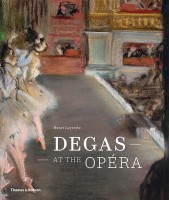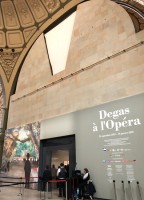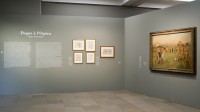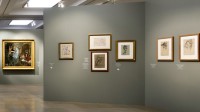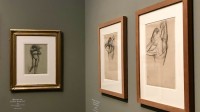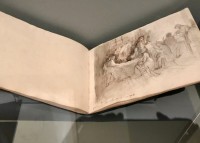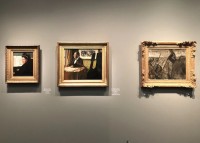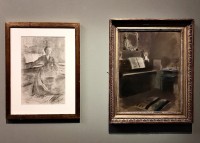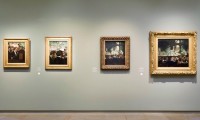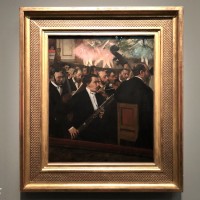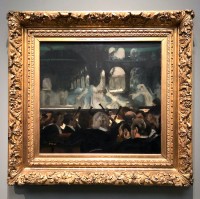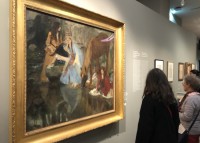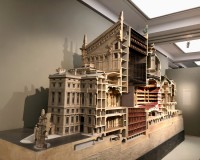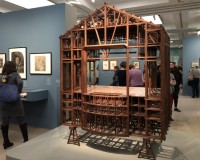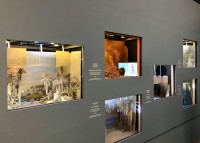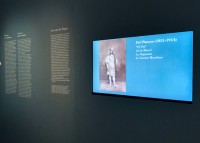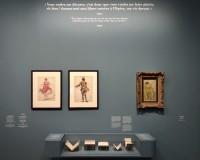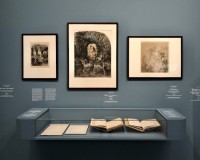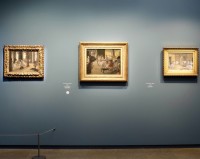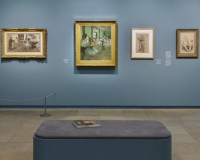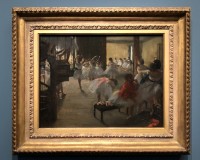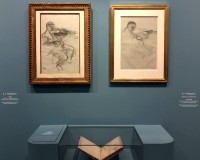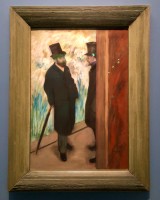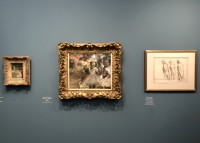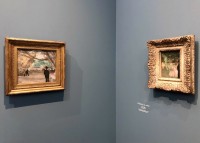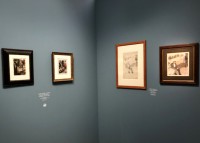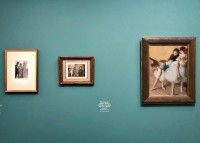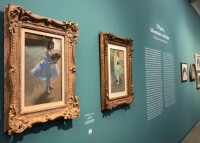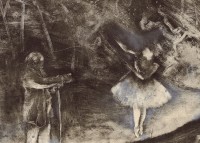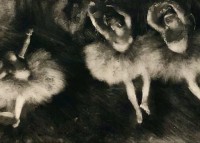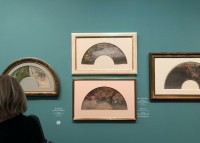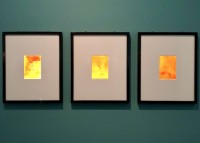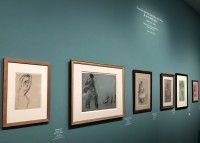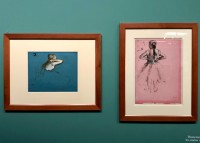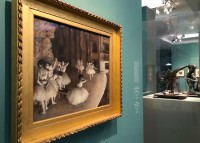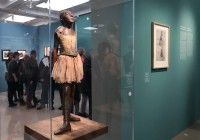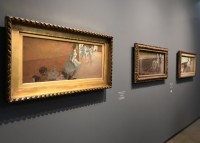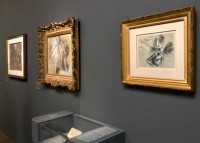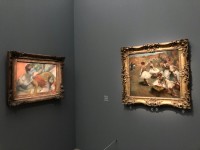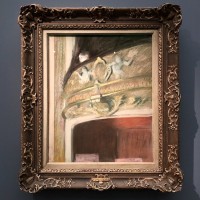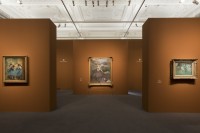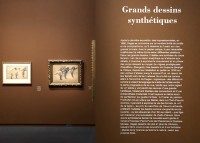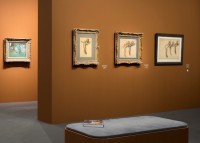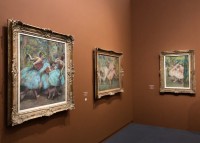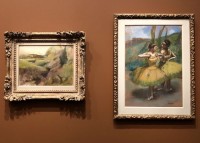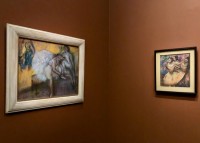The browser will either open the file, download it, or display a dialog.
Degas à l’Opéra
Musée d’Orsay, Paris
September 24, 2019–January 29, 2020
Degas at the Opéra
National Gallery of Art, Washington, DC
March 1–July 5, 2020
Catalogue: Henri Loyrette ed.,
Degas at the Opéra.
London and New York: Thames & Hudson, 2020.
320 pp.; 300 color illus.; bibliography; chronology; notes & references; index.
$49.95 (hardcover)
ISBN–13: 978–0500023396
Lauded as the “peintre des danseuses,”[1] no other artist has delved into the world of ballet as profoundly as Edgar Degas (1834–1917). For four decades, the ballet fired his creative impulses, inspiring a corpus of nearly 1300 works of art. Be it the characterization of the broad cast of dramatis personae he encountered, the technical aspects of a dance position, or the intricacies of backstage sexual politics, he captured these aspects with the acuity and familiarity of an insider. Organized by the Musée d’Orsay, the Musée de l’Orangerie, and the National Gallery of Art, Washington, DC, this exhibition celebrates the 350th anniversary of the Opéra de Paris, which, in addition to being the primary opera company of France, is also the country’s primary ballet company. Degas at the Opéra, which opened in Paris last fall, is not the first exhibition to explore the artist’s passion for ballet, but it is the most comprehensive, immersive, and lavish one to date, and it adds to his ballet pictures those of opera and music.[2] Spanning ten thematically and chronologically organized rooms, the Musée d’Orsay showcased over two hundred works, including sculptures, fans, architectural dioramas, and other exclusive loans of rarely seen objects from the vaults of the Bibliothèque Nationale de France. This panoramic exhibition proposes that many of Degas’s most audacious and ground-breaking innovations came in response to the ballet. As established in the introductory text panel and catalogue by Musée d’Orsay curators Leïla Jarbouai, Marine Kisiel, and Henri Loyrette, and the National Gallery of Art’s Kimberly A. Jones, the Opéra was a “laboratory,” a “veritable catalyst” for Degas’s boldest pictorial inventions and technical experimentations across various media. There, he drew from an endless wellspring of subject matter, mixing and matching motifs observed in situ or conceived in the studio. Thus, closely entwined with this analogy of the Opéra as laboratory was the notion of artifice. As the panel introducing the exhibition explained, “Degas rejects painting from nature, and this transmutation takes place in the studio, filtered by memory, and enriched by his imagination. Hence, while his Opéra may well appear real, it is never true to life.” Experimentation and synthesis were at the heart of Degas’s enterprise—an assertion underscored by the location of the largest gallery, “The Opera, Technical Laboratory,” at the very center of the exhibition’s floorplan.
At the entrance, a large vinyl reproduction of Degas’s The Curtain (ca. 1880) greeted visitors (fig. 1). In the image, ominous men in black, wealthy subscribers to the opera with access to its backstage, prowl amidst the painted shrubbery on the scenery flats, preying upon young dancers, hinting at a nefarious undercurrent at the ballet explored later in the exhibition. The first gallery, entitled “Genetics of Movement,” opened with a sunny scene of ancient Greece: Young Spartan Girls Challenging Boys also known as Spartan Girls Exercising (ca. 1860–62/1880; fig. 2). Partly based on Plutarch’s Life of Lycurgus, this anchor painting provided the entry point that elucidated the link between classical sources and Degas’s dance vocabulary. During his three-year Italian sojourn (July 1856–April 1859), Degas immersed himself in the study of Hellenistic sculpture and Old Masters such as Masaccio, Giotto, Mantegna, and Michelangelo. He also dedicated time to life-drawing at the Villa Medici, where Gustave Moreau instilled in him a new appreciation for colorists like Titian, Veronese, and Delacroix. By the end of his trip, he had amassed an impressive portfolio of copies and studies that would serve as visual references for limitless pictorial inventions. The generous selection of Degas’s early figure drawings underlined the inherited traditions in his approach to the human body (fig. 3). While these works invoked iconic ancient sculptures such as the Borghese Gladiator, Diana of Galbi, and Hermes Fastening his Sandal, they simultaneously prefigured the staple motifs in his ballet repertoire, such as a ballerina’s adjustment of her shoulder strap or a yawn synchronized with an outstretched arm. The integration of Degas’s sketches of dancers revealed his use of classical quotations with their quotidian gestures and poses (fig. 4). To quote Jarbouai from her summation of Spartan Girls Exercising: “What we have are recollections of this classic piece of Greek sculpture [the Borghese Gladiator], refracted through the intensely real presence of a live model” (49). The London painting also reflected the artist’s respect for the petits rats of the Opéra, who embodied the athleticism, strength, discipline, and rigorous training of their Spartan predecessors.[3] On the opposite wall, the Copy after Mantegna’s ‘Crucifixion’ offered additional insight into the sources for Degas’s truncated forms, dynamic figural groupings, and compositional space. As Loyrette aptly notes in the catalogue, the artist’s history paintings from the 1860s can be construed as a “dress rehearsal” for his future opera pictures (31).
All artworks by Degas unless otherwise noted.
The next section, titled “The Musical Circle,” turned the spotlight on Degas the mélomane. His appreciation of music was instilled in him by his banker father, Auguste De Gas, who held weekly musical soirées at their family apartment in Paris. A page from Degas’s sketchbook vividly captured one of the many joyous moments musicaux at home (fig. 5).[4] The elder Degas was an accomplished pianist and both his mother and his sister Marguerite were amateur opera singers. Like Delacroix, Degas reputedly had a fine singing voice, learned how to play the violin, and counted Cimarosa, Gluck, Rameau, and Mozart amongst his preferred composers. Three walls of portraits presented a glittering cross-section of both professional and amateur musicians who attended the weekly salon. The portrait of the singer and pianist Marie Dihau, for example, was displayed alongside musicians of the Paris Opéra (fig. 6). The Song Rehearsal (1872–73) and studies for a portrait of the pianist Blanche Camus (fig. 7) underscored the intimacy of music experienced in the domestic sphere, providing a striking contrast to the cacophony of sound at the theater seen in a dream quartet of Degas’s orchestra pictures (fig. 8). Arranged chronologically from left to right, this compelling hang simulated the raising of the curtain by incrementally revealing the dancers—first with just a glimpse of tutus in Orchestra of the Opéra (1870; fig. 9), and then to an entire corps of phantom nuns in the Ballet from “Robert le Diable” (1876; fig. 10). Characterized by exaggerated oblique angles, close-cropping, and bold geometric divisions that recall ukiyo-e prints and the journalistic illustrations by Honoré Daumier, Adolph Menzel, and Paul Gavarni, the orchestra pictures are amongst his most radical. The recognition of Degas’s musician friends from the pit (identifiable by their instruments) in a number of the individual portraits in the room emphasized the confluence between the private and public musical worlds in which Degas navigated. Visitors were drawn to the most prominently featured (visible from the exhibition’s entrance) and largest work in the room: Degas’s first dance picture, Portrait of Eugénie Fiocre from the Ballet “La Source” (1867–68; fig. 11). Based on Léo Delibes’s ballet, its enigmatic character stems from the absence of narrative, dramatic action, and scenic illusion: “a theatre scene without the theatre.”[5] Preparatory studies related to the Fiocre painting and those of the up-and-coming dancer Joséphine Gaujelin reiterated Degas’s personal connections to his subjects and the privileged view of the Opéra they accorded him.
The following gallery, “The Opéra, From the Salle Le Peletier to the Palais Garnier,” transported visitors to the physical realm of the theatre through a plethora of opera paraphernalia in several media. Many of the objects were exclusively on loan to Musée d’Orsay from the Bibliothèque nationale de France due to their fragility. The most impressive of these was a large-scale cross-section maquette of the Palais Garnier (fig. 12) and a model of its stage (fig. 13). At one corner, a marvelous display of scenographic dioramas presented the most celebrated Romantic operas and ballets of the time. These included Gaetano Donzietti’s La Favorite, Daniel Auber’s La Muette, and Charles Gounod’s Faust (fig. 14). On the adjacent wall, a projection slide show, “The Voices of Degas,” featured audio excerpts of opera performances that Degas attended (fig. 15). Also included were costume designs for Théodore Lajarte’s Les Jumeaux de Bergame (fig. 16) and Charles-Marie Widor’s La Korrigane, various posters, and sign-in lists with names of subscribers who entered through the guarded porte de la communication (fig. 17). The Palais Garnier only represented, however, one chapter of Degas’s balletomania. For more than fifty years, the national ballet’s home was on the Rue le Peletier, close to Montmartre. Built in 1820–21, the dilapidated building was destroyed by fire in 1873. The new Opéra, considered then to be crown jewel of the Second Empire, was inaugurated in 1875, but its grandeur and sumptuous décor did not appeal to Degas’s aesthetic, politics, or sentiment.
Degas’s iconic images of the Salle Le Peletier’s cavernous ballet rehearsal rooms were highlighted in the gallery “House, Stage, Backstage.” By the 1870s, Degas had access to these rooms, where he observed dancers stretching at the barre, resting on a bench, or performing under the scrutiny of a dance master (figs. 18, 19). Characterized by wide-angle viewpoints, sharp recessions, brazen cropping, and contre-jour lighting effects, the rehearsal space was a long-term catalyst for his most radical compositional experiments. Glimpses of architectural details outside the window or a pilaster and cornice inside provided clues of the locale, but as The Dance Class (ca. 1873; fig. 20) revealed, some elements were purely artificial. For example, the staircase was in fact a prop from the artist’s studio! The majority of the rehearsal pictures on display were in progress at the time of the fire; thus, vestiges of the old opera house remained in pictures completed after its destruction. At the same time, The Dance Lesson (ca.1876; fig. 18) showed that elements of the décor of the Salle le Peletier persisted in works commenced after the fire: some paintings were a synthesis of memories of the past and observations of the present. Driven by his strong sense of nostalgia and loyalty to the old theatre, Degas also managed to entice the former star and choreographer of the Romantic ballet, Jules Perrot, out of retirement (fig. 19, far right) to resume the role of ballet master in these pictures. A display featuring drawings and pastels of violinists evoked the soundscape of the rehearsal room (fig. 21).
Degas’s Portrait of Friends on the Stage (1879; fig. 22) set the scene for the next section, “‘Serious in a Frivolous Place,’ the Subscribers.” The quotation in the room’s title was used by the librettist, novelist, and playwright Ludovic Halévy (1838–1908) to describe Degas. Halévy played an instrumental role in facilitating the artist’s behind-the-scenes access at the new Opéra. Best known for his Cardinal novellas (1870–71), Halévy chronicled the romantic misadventures of Pauline and Virginie, dancers from the old Opera on the Rue Le Peletier, and their enterprising mother. These stories were based on his shrewd observations of life at the Opéra (fig. 23); hence, his protagonists mirrored their real-life counterparts. Young girls, typically from the lower classes, entered the brutally competitive arena of the ballet at age seven or eight. As they rose through the ranks, their stipends increased, enabling them to supplement the family income. Aspirations to become a principal dancer (coryphée) were tied to their ability to procure the financial support of an affluent male subscriber (abonné) from the city’s political and commercial elite (fig. 24). While sordid and corrupt, this practice was an accepted fact in Parisian society, which saw the Opéra as a site for sexual commerce and assumed that many of the dancers were courtesans, if not prostitutes, offstage.[6] Degas produced about forty monotypes inspired by Halévy’s La Famille Cardinal. These prints were typically heightened with charcoal and colored pastel (fig. 25). In the examples on display, predatorial abonnés appear en masse or singly, watching possessively from the wings and often with the enterprising Madame Cardinal nearby to secure the most lucrative affairs (figs. 25, 26). The intelligent groupings effectively illustrated the convergence between Degas’s and Halévy’s interests and their marriage of fact and fiction.
The astounding breadth of the next gallery, “The Opera as Technical Laboratory,” reflected what Jones articulated in her excellent, focused study of Degas’s technical and pictorial inventions as his “fervor for experimentation” (179; fig. 27). The importance of printmaking as a creative catalyst— “the impetus for his innovative exploration of varying techniques” (170) was evinced by several featured works on paper that fused aquatint, drypoint, and lithography. The monotype received special attention as it was a form that Degas invented with his opera-going friend, Ludovic Lepic. The Ballet Master (1875; fig. 28), a monotype he made with Lepic, demonstrated that the medium’s intrinsic properties, together with his frequent use of the manière noire method, worked ideally to produce the atmospheric shadows and stark contrasts of light and dark in his theater scenes (fig. 29).
A dazzling array of fans drew visitors to the text panel introducing the gallery (fig. 30). The craze for Japonisme and the influx of Spanish culture sparked by Napoleon III’s marriage to Princess Eugénie propelled the fan’s popularity in the mid-nineteenth century. Its challenging format no doubt appealed to Degas, who had intended to mount a roomful of them at the Impressionist Exhibition of 1879. He produced twenty-seven in all using different combinations of ink, watercolor, metallic paint, gouache, and pastel. This section also included three photo negatives taken by Degas, who acquired his first camera in 1895—the same year that the Lumière brothers debuted their films in Paris (fig. 31). Ingresque in their classicism and intimate in mood, the poses captured in these photographs were echoed by the rich display of mixed media drawings on the opposite wall. The variety of these works on paper highlighted Degas’s tireless efforts to discover the full potential of his materials (fig. 32). For example, during the first half of the 1870s, he developed a method called peinture à l’essence in which he removed the excess oil from his paint and then diluted it with turpentine. He often applied this medium to chalk or charcoal drawings on tinted papers; its fluidity enabled him to capture poses in swift, calligraphic lines (fig. 33).
The last thematic section in “The Opera as Technical Laboratory” centered on Degas’s sculptural works. While his small wax figures of dancers were seamlessly integrated with other works (fig. 34), the iconic Little Dancer, Aged Fourteen commanded the room (1878–81; fig. 35). Presented at the Impressionist Exhibition of 1878, this was the only sculpture that the artist showed during his lifetime. Its reception was vitriolic from the outset, a result of Degas’s realistic rendering and unconventional use of clay, pigmented wax, and real hair—materials that subverted archaic notions of high art and its techniques. Moreover, critics were outraged by Degas’ immoral and base subject matter. The model was a dancer at the Opéra named Marie van Goethem, and whether critics recognized her or not, they were quick to associate her with prostitution, the fate of many ballerinas as recounted in the Cardinal novellas (255, 258). To reinforce this link, the Little Dancer, Aged Fourteen was visible from the gallery with Degas’s illustrations of Halévy’s work.
“Elongated Panels,” the title of the next section, focused on six of Degas’s double-square compositions, canvases twice as wide as they are tall (fig. 36). His first foray into this format was in 1878; in the following year, he submitted The Dance Lesson (1879, National Gallery of Art, Washington, DC) to the Impressionist Exhibition. In these works, the exaggerated plunging diagonals and rhythmic arrangement of figures across the broad expanse of space imbue the tableaux en long with not only dynamism but also a magnetism that draws the beholder towards the vanishing point. A variety of influences came to the fore in this format: the procession-like arrangement of the dancers in some of these works harkens back to Quattrocento predelle and ancient friezes, the asymmetry, brazen cropping, and activated edges recall ukiyo-e prints, and finally, the cadenced rise and fall of the figures along the same trajectory line imparts a temporality reminiscent of Eadweard Muybridge’s and Étienne-Jules Marey’s chronophotography. One wall was dedicated to a small number of drawings and pastels that exemplified the freedom with which Degas transposed a motif from one work to another (fig. 37). One figure who appears in the elongated panel painting Before the Ballet (1890–92), Dancer Adjusting her Slipper (1885), and Seated Dancer Massaging her Foot (1881–83). Had the three works been hung closer together, the connection would have been more immediate.
“Lighting Effects and Viewpoints” presented a concise selection of works that captured Degas’s fascination with light’s ability to exaggerate, distort, and sculpt a dancer’s body. To amplify the sense of theatricality, he combined chiaroscuro effects, intense backlighting, and luminous accents with dramatic viewpoints. It was not until 1885 that Degas could afford a three-day subscription to the Opéra, which provided him with access to all areas of the theater. Some of the works in this section reveal the spaces and viewpoints that his pass allowed him to explore. The juxtaposition of Women in a Theater Box (1885–90) with Dancers on Stage (1889–94; fig. 38) brilliantly underlined the relationship between site and sight—i.e., the spectator’s seat in the loge and what is seen on the stage from that vantage point. A more important loge scene was the Study of a Theater Box (1880; fig. 39) as it was one of only two ballet pictures in Degas’s oeuvre that featured the Palais Garnier. In her essay, Jones correctly connects Degas’s loge pictures to Mary Cassatt’s influence. Although gender politics and the rhetoric of the voyeuristic gaze were not alluded to in the label copy, they are addressed in the catalogue.
The last two sections of the exhibition were visually united by an elegant arch, intense, terracotta-colored walls, and a vista that culminated in Dancer with Bouquets (ca. 1895–1900; fig. 40). The first room, “Large Synthetic Drawings” (fig. 41), concentrated on Degas’s large format charcoal and pastel drawings from the 1890s and 1900s. Primarily executed on tracing paper, the translucency of this surface enabled him to make copies at ease, reworking and recontextualizing familiar motifs from individual drawings to create myriad new aggregates. This process was clarified by a sequence of three drawings—each based on the same nude model (fig. 42). The “synthetic” nature of this genre also refers to Degas’s practice of drawing a single figure multiple times to evoke the temporal unfolding of a movement across the page. Faceless, corporeal, and at times coarse in execution, these figures are also uninhibitedly expressive and rendered in wonderfully gestural lines. These late works embodied a distinctly modern “new form of beauty” that paradoxically “embraced the vulgar and the sublime.”[7] The majority of critics, however, could not look beyond the Ingresque idiom that typified Degas’s classical dancers from the previous decades.
The title for the final section was inspired by an expression that Degas once used with Julie Manet (Berthe Morisot’s daughter) to describe his pastels of dancers in Russian costumes: “Orgies of Color” (fig. 42). The space effectively showcased his late pastels and paintings, whose riotous, almost electric colors vibrated against the terracotta walls (figs. 43, 44, 45). As Degas’s eyesight deteriorated, he experimented with new techniques to amplify the vibrancy of his colors. For instance, he vigorously texturized the surface of the canvas using a variety of tools to create indents that would absorb more pigment. For his pastels—of which the majority were executed on tracing paper—fixatives reinforced the delicate surface, allowing for additional layers of pigment. Together, the texture and saturation produce colors with remarkable depth, while tiny touches of color, suggestive of sequins and beads, scintillate on the surface. During these twilight years, his predilection was for pastels, as they were less time-consuming, less straining for his eyes, and did not require any tools. He exulted in their immediacy, their expressiveness, and the possibility they provided to draw in color and line all at once. Above all, he was enticed by the velvety, pollen-like quality of pastels, which was ideally suited for his rendering of gauze, tulle, satin, and skin. The exuberant explosion of color ended the exhibition on a celebratory note, and Dancer with Bouquet appeared to bid visitors a most memorable farewell.
Degas at the Opéra succeeded in recreating the opulent world of the ballet through the abundance of riches drawn from the Musée d’Orsay’s permanent collection, the loans from the Bibliothèque Nationale de France, and key works from international lenders. The exhibition’s encyclopedic scope, labyrinthine layout, and extended label copy were almost overwhelming, but surely for ballet aficionados and ardent admirers of Degas, the experience was an exhilarating and illuminating one. Poor design made the exhibition catalogue a challenge to navigate. For instance, it employs in places purple and black text printed on either white, pink, soft sage, or gray-blue paper; the typeface is only bolded on the colored pages; the slashed zeros in the footnotes are almost illegible, and page numbers sometimes appear between the gutter, bottom corners, or nowhere at all. The lavish illustrations do much to make up for these design inconsistencies and impracticalities. The essays reflect a great diversity of expertise and include Marine Kisiel’s research on the choreographic shorthand of the period, Jones’s irrepressible love of fans, Jarbouai’s nuanced insights on the artist’s graphic works, and Loyrette’s three decades of Degas scholarship. As with many catalogues with multiple authors, there is inevitably some overlap in the content of the essays. Yet with nineteen essays, in total spanning the entirety of Degas’s career, the catalogue provides ample new scholarship on a wide variety of topics.
Corrinne Chong, PhD
Independent art historian and curator
corrinnecareens[at]gmail.com
[1] Jules Claretie, La Vie à Paris, (Paris: Victor Harvard, 1881), 110.
[2] Notable exhibitions of Degas and the ballet include: Degas and the Dance organized by the American Federation of Art, The Detroit Institute of Art (October 20, 2002–January 12, 2003) and the Philadelphia Museum of Art (February 12–May 11, 2003); Degas and the Ballet: Picturing Movement organized by the Royal Academy of Arts, London (September 11–December 11, 2011), and Degas’s Dancers at the Barre: Point and Counterpoint at the Phillips Collection, Washington, DC, (October 1, 2011–January 8, 2012).
[3] Degas also saw the parallels between his vocation as an artist and that of a dancer: both entailed discipline, industry, and the constant perfection of their skills. From the author’s interview with curator Leïla Jarbouai at the Musée d’Orsay on November 26, 2019.
[4] For several years, the portrait held a place of honour over the artist’s bed.
[5] In fact, the only indication that betrays its connection to the ballet is an inconspicuous pair of ballet shoes between the horse’s legs. See Richard Kendall and Jill Devonyar, Degas and the Dance (New York: Harry N. Abrams, 2002), 37.
[6] Robert L. Herbert, Impressionism: Art, Leisure, and Parisian Society (New Haven: Yale University Press, 1991), 110.
[7] From the author’s interview with Leïla Jarbouai at the Musée d’Orsay on November 26, 2019.


